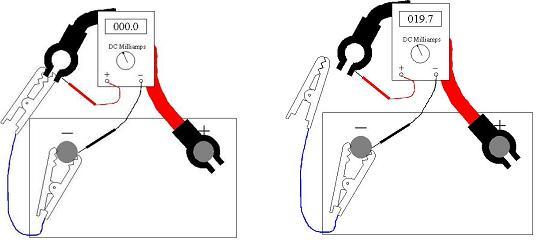You're looking for a problem that isn't there. You can't read a current draw by putting a voltmeter in series with a battery cable. You WILL read 12 volts since essentially you're still reading right across the battery, with the car's circuitry stuck in the middle. To look for a draw, you have to put the meter on "DC amps". The sparks you saw when you reconnected the last battery cable is normal. That is from all of the memory circuits in the numerous computers charging up.
If it helps, voltage is electrical pressure, just like pressure in a compressed air line. No air flows THROUGH the pressure gauge, and practically no current flows through a voltmeter. Current is the flow, just like the volume of air flowing in the air line. It's the current you're worried about when it comes to a drain on the battery. For all practical purposes, an ammeter is just a piece of wire and causes almost no reduction in the amount of current that is flowing.
It sounds like I wasn't clear in my description of "sleep" mode. You appear to be referring to leaving the battery disconnected for more than 20 minutes. What happens is it takes 20 minutes for some computers to go into sleep mode AFTER the battery is reconnected. That means if you want to measure the drain on the battery, you have to insert the ammeter, then wait more than 20 minutes to take a reading.
A whole new bunch of problems comes in when doing this on computerized cars. Once the computers power down, anything you do to momentarily cause an open circuit, (break in the circuit), will wake those computers up again. Then you'll have to wait another 20 minutes.
Most digital meters have "2 amp", "200 milliamp", and "20 milliamp" scales, all protected by a 2 amp fuse, and a separate "10 amp" scale that requires you to move the positive meter lead to a different jack. You need to put the meter on the 200ma scale to get the needed accuracy, but if the computers are awake yet, they can draw up to 3 amps. That will blow the meter's fuse. Instead, you have to start on the 10 amp scale, then wait for the reading to drop after 20 minutes. Once that happens, you can switch to the lower scale, but to do that you have to unplug the meter lead and move it to a different jack. You just opened the circuit by doing that and when the lead is connected to the 200ma scale, the computers will wake up, draw 3 amps, and blow the meter fuse.
If you have a meter that has the 10 amp scale switched in with the knob instead of having to move the lead, turning the knob first opens the circuit to the 10 amp scale, THEN makes the connection to the 2 amp scale. That's called a "break before make" switch and is the most common style. That momentary break as you switch scales is enough to wake the computers up again. Even if the fuse doesn't blow in the meter, you will still have to wait another 20 minutes for the computers to time out.
All of that can be avoided by putting a small jumper wire across the meter leads. Remove the jumper so all current has to go through the meter when you want to read the value of that current. Reconnect the jumper momentarily when you want to switch scales. The current will continue to flow through the jumper wire and the computers will not wake up.
Check out these sad drawings. On the left the jumper is connected so the scale can be switched on the meter. On the right the jumper is removed so all the current has to go through the meter where it can be read.
This is where you're looking for 35 milliamps or less. At 35 ma, Chrysler says a good battery will still crank the engine enough to start after sitting for three weeks. On some models, Cadillacs in particular, 50 milliamps is allowable.
Image (Click to make bigger)
Sunday, February 10th, 2013 AT 3:12 AM





